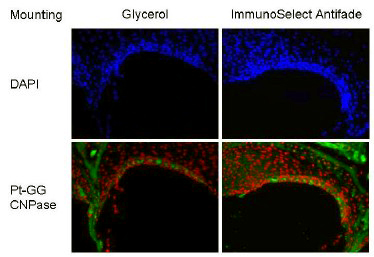Immunoselect Antifading Mounting Medium PI
- Images (2)
| Article Name: | Immunoselect Antifading Mounting Medium PI |
| Biozol Catalog Number: | DNA-SCR-038449 |
| Supplier Catalog Number: | DNA-SCR-038449 |
| Alternative Catalog Number: | DNA-SCR-038449,SCR-038449 |
| Manufacturer: | dianova |
| Category: | Sonstiges |
| Application: | IHC |
| Immunoselect Antifading Mounting Medium PI |
The rapid photobleaching of cell probes labelled with fluorochromes has always hindered the qualitative and quantitative assessment of the label. ImmunoSelect® Antifading Mounting Medium is developed for fluorescence-microscopical use combining strong initial fluorescence with drastical reduction of photobleaching over time. In contrast to several media ImmunoSelect® Antifading Mounting Medium does not exhibit autofluorescence at any common wavelength. ImmunoSelect® Antifading Mounting Medium is an aqueous mountant which does not solidify directly, but remains a viscous liquid for several days on the slide. To mount cellular material on the slide one drop of medium is sufficient. After a cover slip is applied, the medium disperses over the entire section. When mounted slides are stored at 4°C in the dark, fluorescence will remain for many weeks. ImmunoSelect® Antifading Mounting Medium is ready to use and available with or without DNA Fluorescent Dyes (DAPI or PI (propidium iodide)).
Immunoselect Antifading Mounting Medium is tested for several fluorescence dyes: |
| Storage: | 2-8°C |
| Caution: | NULL |



